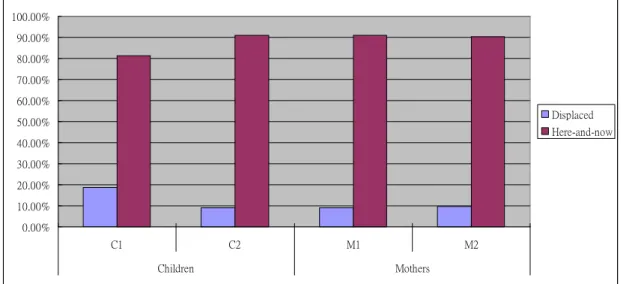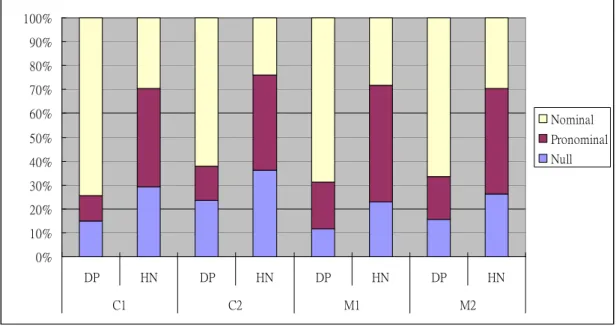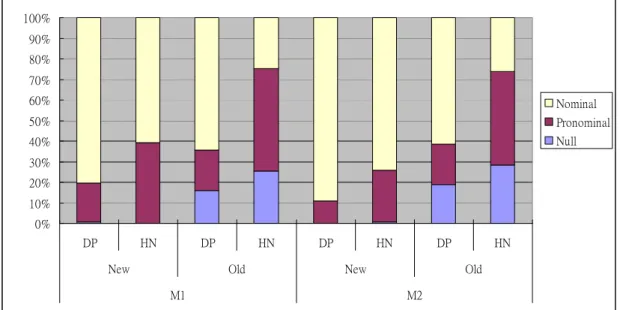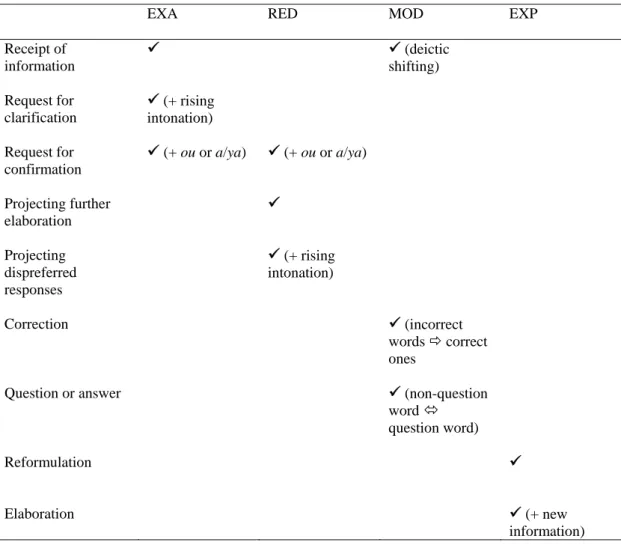行政院國家科學委員會專題研究計畫 成果報告
漢語親子對話中的移位指涉
研究成果報告(精簡版)
計 畫 類 別 : 個別型 計 畫 編 號 : NSC 99-2410-H-004-205- 執 行 期 間 : 99 年 08 月 01 日至 100 年 07 月 31 日 執 行 單 位 : 國立政治大學語言學研究所 計 畫 主 持 人 : 黃瓊之 計畫參與人員: 碩士班研究生-兼任助理人員:鍾易儒 報 告 附 件 : 出席國際會議研究心得報告及發表論文 處 理 方 式 : 本計畫可公開查詢中 華 民 國 100 年 10 月 28 日
1. Introduction
It is well-known that Mandarin permits omitted arguments. In Mandarin, overt
reference forms can be omitted provided that the referent can be understood from the
context (Huang, 2000; Li & Thompson, 1981, Wang et al., 1992). In other words,
Mandarin speakers’ referential choice may be discourse-motivated. Previous studies
have indicated that adult speakers show sensitivity to discourse-pragmatic factors
presumed to underlie the differential use of referring expressions in discourse (Chafe,
1994, 1996; Du Bois, 1985, 1987; Givon, 1983; Gundel, Hedberg & Zacharski, 1993;
Kumpf, 1992).
In language acquisition research, grammar and discourse are frequently treated
as separate domains that do not interact in any significant way. Given the success of
the discourse-pragmatic approach in explaining the distribution of referring
expressions in adult language, recently a few studies have investigated the child’s
referential choice from this use-oriented perspective. It has been reported that the
child’s referential choice can also be explained by pragmatic principles (Allen, 2000;
Clancy, 1993; 1997; Guerriero, Oshima-Takane & Kuriyama, 2006; Huang, 2011;
Narasimhan, Budwig & Murty, 2005; Serratrice, 2005).
An important pragmatic feature which may influence referential choice is
displacement. This feature characterizes a referent that is not present in the immediate
context of the conversation. Displacement is one of language’s essential functions.
Research on child language acquisition has shown that children’s speech at the early
stage of development is restricted to the ‘here-and-now’ (Brown, 1973; Sachs, 1983;
Eisenberg, 1985; Weist, 1989). The development of the capacity to refer to objects
and events temporally or spatially displaced from the immediate context represents a
crucial conceptual and linguistic breakthrough for young children. Thus, how children
linguistics and psychology (Adamson & Bakeman, 2006; Eisenberg, 1985; Huang,
2000; Lucariello and Nelson, 1987; Morford and Goldin-Meadow, 1997; Sachs, 1983;
Veneziano, 2001).
Previous studies have identified several characteristics of the child’s initial
conversation about displaced reference: the predominance of the adult’s scaffolding,
the reference to routine events and the reference to the immediate past/future.
However, few studies have examined the referential expressions the child uses for
displaced reference. Since displaced reference can not be achieved through the aid of
the immediate contextual information, a greater communicative demand is placed on
the child to be linguistically informative when talking about the ‘there-and-then’.
Referential strategies for displaced reference thus constitute a link between grammar,
discourse pragmatics, and cognitive development. Therefore, the purpose of this study
was to investigate Mandarin-speaking children’s referential choice for displaced
reference. The children’s referential choice for displaced reference was further
examined in relation to the new vs. old information status, a factor which has been
shown to influence Mandarin speakers’ referential choice (Gundel, et al., 1993;
Hickmann & Hendriks, 1999; Huang, 2000; Li & Thompson, 1981; Wang et al., 1992).
In addition to the speech of Mandarin-speaking children, this study also analyzed the
speech of the children’s mothers in order to understand the similarities and differences
between the children’s and the mothers’ referential strategies for displaced reference.
2. Methods
2.1 Participants and data
The participants of this study were two Mandarin-speakingtwo-year-old girls
and their mothers, who lived in the northern part of Taiwan. One of the children had a
had received post-graduate education. The data used in this study consisted of eight
hours of natural mother-child conversation video-taped at the children’s homes, with
four hours of data with each child. The collected data were transcribed using CHAT
convention (MacWhinney, 2000) for analysis.
2.2. Coding scheme
The children’s and the mothers’ utterances were examined to indentify the
instances of here-and-now references and displaced references. Referential forms
used for these references were analyzed. In addition, further analysis was conducted
to examine whether these references involved new information or old information.
The coding scheme is as follows.
1. Types of references
(a) Here-and-now references: Referring to a referent that is present in the
physical context of the conversation
(b) Displaced references: Referring to a referent that is not present in the
physical context of the conversation
2. Referential forms
(a) Null forms: Absence of overt form
(b) Pronominal forms: Including pronouns and demonstratives
(c) Nominal forms: Including bare nouns, noun phrases, and proper names
3. Information status
(a) New information: A referent that has not been previously talked about in
the conversation at hand
(b) Old information: A referent that has been previously talked about in the
3. Results
Analysis was conducted to examine the types of referents the children and the
mothers referred to, i.e., whether they referred to displaced referents or here-and-now
referents. The results are shown in Figure 1. Figure 1 shows that the two children
referred mainly to here-and-now referents, and that they referred to displaced
referents for only about 10% to 20% of the time. Similarly, the referents mentioned in
the mothers’ speech were also mostly here-and-now referents; displaced referents
occurred only about 10% of the time in the mothers’ speech. The results suggested
that the conversations of the mother-child dyads focused mostly on the here-and-now.
0.00% 10.00% 20.00% 30.00% 40.00% 50.00% 60.00% 70.00% 80.00% 90.00% 100.00% C1 C2 M1 M2 Children Mothers Displaced Here-and-now
Figure 1: Proportions of displaced and here-and-now references
Table 2 shows the distributions of referential forms used for displaced references
and for here-and-now references. As seen in Figure 2, the distributions of referential
forms for the two types of references revealed very different patterns of use. When
referring to displaced referents, the children and the mothers used a high rate of
nominal forms; the percentage of nominal forms became much lower when they
null forms and pronominal forms to refer to here-and-now referents more frequently
than they used these forms to refer to displaced referents. The results suggested that
the children and the mothers were sensitive to the feature of displacement in their
referential choice. 0% 10% 20% 30% 40% 50% 60% 70% 80% 90% 100% DP HN DP HN DP HN DP HN C1 C2 M1 M2 Nominal Pronominal Null
Figure 2: Distributions of referential forms for displaced and here-and-now references
The referential forms used for the two types of references were further examined
in relation to the new vs. old information status. The results are presented in Figures
3a and 3b. We observed that the general distributions of referential forms in the new
information condition were different from those in the old information condition; the
children and the mothers used much less null forms and much more nominal forms for
new information than for old information. A closer look at the results revealed that
null forms were used most frequently for here-and-now references with old
information, and least frequently (close to 0%) for both displaced and here-and-now
references with new information. In contrast, nominal forms were used most
here-and-now references with old information. There appeared to be a cumulative
effect of the factors of displacement and information status.
0% 10% 20% 30% 40% 50% 60% 70% 80% 90% 100% DP HN DP HN DP HN DP HN
New Old New Old
C1 C2
Nominal Pronominal Null
Figure 3a: Distributions of referential forms for displaced and here-and-now
references in new vs. old conditions in children’s data
0% 10% 20% 30% 40% 50% 60% 70% 80% 90% 100% DP HN DP HN DP HN DP HN
New Old New Old
M1 M2
Nominal Pronominal Null
Figure 3b: Distributions of referential forms for displaced and here-and-now
references in new vs. old conditions in mothers’ data
4. Conclusion
different referential strategies for here-and-now and for displaced references; the
children tended to use nominal forms for displaced references, and null forms and
pronominal forms for here-and-now referents. Their referential choice appeared to be
influenced by the feature of displacement. The children’s referential choice was also
influenced by the new vs. old information status, and there appeared to be a
cumulative effect of the factors of displacement and information status. The results
also revealed that the children’s referential strategies were similar to those of the
mothers, suggesting that the children’s and the mothers’ referential strategies may be
References
Adamson, L. B. & Bakeman, R. (2006). Development of displaced speech in early
mother-child conversations. Child Development, 77(1), 186-200.
Allen, S. (2000). A discourse-pragmatic explanation for argument representation in
child Inuktitut. Linguistics, 38, 483-521.
Brown, R. (1973). A first language. Cambridge, MA: Harvard University Press.
Chafe, W. (1994). Discourse, consciousness, and time: The flow and displacement of
conscious experience in speaking and writing. Chicago: University of Chicago
Press.
Chafe, W. (1996). Inferring identifiability and accessibility. In T. Fretheim & J.
Gundel (eds.), Reference and referent accessibility (pp. 37-46). Amsterdam:
John Benjamins.
Clancy, P. (1993). Preferred argument structure in Korean acquisition. In E. Clark
(ed.), The proceedings of the Twenty-Fifth Child Language Research Forum (pp.
307-314). Stanford, CA: CSLI.
Clancy, P. (1997). Discourse motivations for referential choice in Korean acquisition.
In H. Sohn & J. Haig (eds). Japanese/Korean Linguistics, Vol 6 (pp. 639-657).
Stanford, CA: CSLI.
Du Bois, J. W. (1985). Competing motivations. In J. Haiman (ed.), Iconicity in syntax
(pp. 343-365). Amsterdam: John Benjamins.
Du Bois, J. W. (1987). The discourse basis of ergativity. Language, 63, 805-855.
Eisenberg, A. R. (1985). Learning to describe past experiences in conversation.
Discourse Processes 8, 177–204.
Givon, T. (1983). Topic continuity in discourse: an introduction. In J. H. Greenberg &
3. Topic continuity in discourse: a quantitative cross-language study.
Amsterdam: John Benjamins.
Guerriero, A. M. S., Oshima-Takane, Y., Kuriyama, Y. (2006). The development of
referential choice in English and Japanese: a discourse-pragmatic perspective.
Journal of child language, 33, 823-857.
Gundel, J., Hedberg, N. & Zacharski, R. (1993).Cognitive status and the form of
referring expressions in discourse. Language, 69, 274-307.
Hickmann, M. & Hendriks, H. (1999). Cohesion and anaphor in children’s narratives:
A comparison of English, French, German, and Mandarin Chinese. Journal of
Child Language, 26, 419-452.
Huang, C. (2011). Referential choice in Mandarin child language: A
discourse-pragmatic perspective. Journal of Pragmatics, 43, 2057-2080.
Huang, Y. (2000). Anaphora; A crosslinguistic study. Oxford: Oxford University
Press.
Kumpf, L. E. (1992). Preferred argument structure in second language discourse: A
preliminary study. Studies in Language, 16, 369-403.
Li, C. N. & Thompson, S. A. (1981). Mandarin Chinese: A Functional Reference
Grammar. University of California Press, Berkeley, CA.
Lucariello, J. & Nelson, N. (1987). Remembering and planning talk between mothers
and children. Discourse Processes 10, 219–35.
MacWhinney, B. (2000). The CHILDES project: Tools for analyzing talk, 3rd ed.
Mahwah, NJ: Lawrence Erlbaum.
Morford, J. P. & Goldin-Meadow, S. (1997). From here and now to there and then:
The development of displaced reference in homesign and English. Child
Narasimhan, B., Budwig, N. & Murty, L. (2005). Argument realization in Hindi
caregiver-child discourse. Journal of Pragmatics, 37, 461-495.
Sachs, J. (1983). Talking about the there and then: the emergence of displaced
reference in parent–child discourse. In K. E. Nelson (ed.), Children’s language.
Hillsdale, NJ: Erlbaum.
Serratrice, L. (2005). The role of discourse pragmatics in the acquisition of subjects in
Italian. Applied Psycholinguistics, 26, 437-462.
Veneziano, E. (2001). Displacement and informativeness in child-directed talk. First
Language 21, 323-356.
Wang, Q., Lillo-Martin, D., Best, C. T., Levitt, A. (1992). Null subject versus null
object: Some evidence from the acquisition of Chinese and English. Language
acquisition, 2(3), 221-254.
Weist, R. M. (1989). Time concepts in language and thought: filling the Piagetian
void from two to five years. In Levin, I. & Zakay, D. (eds), Time and human
國科會補助專題研究計畫項下出席國際學術會議心得報告
日期: 100 年 6 月 30 日 計畫編號 NSC 99-2410-H-004-205- 計畫名稱 漢語親子對話中的移位指涉 出國人員 姓名 黃瓊之 服務機構 及職稱 國立政治大學語言學 研究所副教授 會議時間 100 年 6 月 26 日至 100 年 6 月 27 日 會議地點 日本大阪會議名稱 The 13th Annual International Conference of the Japanese Society
for Language Sciences 發表論文
題目
A functional analysis of parental other-repetition in Mandarin parent-child interaction
本人於 100 年 6 月 26 日至 27 日參加由日本語言科學學會(the Japanese Society for Language Sciences)所主辦的國際研討會 The 13th Annual International
Conference of the Japanese Society for Language Sciences。此研討會集合了許多來 自世界各地研究語言科學的學者,會中也有不少來自台灣的教授及學生。與會學 者從語言科學的各個面向,作研究的分享與交流。兩天的研討會,讓參與研討會 的成員享受了一次豐富的學術饗宴。
本次會議包含了 26 篇 individual papers 和 21 篇 posters,另外還包括了 2 場 plenary talks 及 1 場 invited symposium。Plenary talks 邀請演講的學者分別為 Professor Niko Besnier (University of Amsterdam)及 Yasuhiro Katagiri (Future University Hakodate),前者的講題為 Language on the Edge of the Global: Linguistic Practices, Agency, and the Complexity of the Local 而後者則為 Cultural parameters in conversational interactions。Invited symposium 的主題則為 Reconsidering ‘communicative competence’: Findings and suggestions from fieldwork/empirical research。精彩的內容讓與會者收穫豐富。 兩天共 26 篇的 individual papers 分成三個平行場次進行,讓與會者依興趣選 擇參加。發表的論文中有 4 篇是來自台灣的研究,顯示台灣的學者及學生積極參 與國際學術研討會發表研究成果。會議的第二天安排了 1 小時 20 分鐘的時間讓 21 篇 posters 的作者在作品前和與會者進行面對面的說明及討論,其中也包括了 2 篇來自台灣的研究。近距離的互動不僅讓與會者對各個研究展示有更清楚的瞭 解,也讓各研究發表者能獲得和與會者即時交流的機會。
in Mandarin parent-child interaction。本研究的目的是從 discourse-pragmatic 的觀 點探討說漢語的父母在與幼童的自然對話中,重複幼童語句時的語言形式與語用 功能。本人的論文獲得了不少與會學者正面的回應,同時一些意見及問題也對我 繼續發展本篇論文有很大的幫助。 此次參加 JSLS2011 不僅有機會發表本人的研究成果之外,也有機會與不同 領域、不同國家的學者做學術討論與交流,是次很有意義、很豐富的學術經驗。
JSLS 2011_ue!QT 回信 全回 轉寄 | 廣告信 | 移至.. 12 / 14篇 來源:Y. Hirakawa <y.hirakawa55@gmail.com> 收信:cchuang@nccu.edu.tw 標題:JSLS 2011 日期:Fri, 1 Apr 2011 12:53:02 +0900
Dear Chiung-chih Huang,
On behalf of the organizing committee for JSLS 2011, I apologize for the delay in informing you of our decision regarding your submission.
We are pleased to inform you that your abstract has been accepted as an oral presentation (paper) at JSLS 2011.
In order for us to secure your place at the conference, we must receive e-mail confirmation of your intention to present at JSLS 2011 by April 8, 2011. Please send your confirmation to: jsls2011-wg@cyber.sist.chukyo-u.ac.jp
Please use the following format in your reply: ---cut---Title:
Author(s):
I (will/will not) present a paper at JSLS 2011.
---cut---We would also like you to submit a 4-page paper for inclusion in the conference handbook. More information about this will be sent after we receive your confirmation.
We look forward to your response. JSLS 2011 Review Committee (Yahiro Hirakawa, Chair)
---ps. Dear all
The conference will be held as scheduled (June 25-26, 2011). Osaka and its vicinity are not impacted by the earthquake on March 11th in the northern Japan. All the public transportations and facilities are running normally. Please visit this website often to check for further updates.
JSLS 2011 Conference Chair Keiko Ikeda
The Japanese Society for Language Sciences JSLS 2011 Conference Handbook
A functional analysis of parental other-repetition in Mandarin parent-child interaction
Chiung-chih HUANG (National Chengchi University)
Abstract
This study investigated the types and functions of parental other-repetition in Mandarin parent-child interaction from a discourse-pragmatic perspective. The subjects of this study were two Mandarin-speaking parent-child dyads. The data included six hours of natural conversations recorded when the children were between the ages of 2;1 and 3;1. Parental other-repetitions were classified into four repetition types: exact, reduced, modified, or expanded. The different types of repetitions were further analyzed to examine their pragmatic functions. It was found that the parents used the different types of repetition for a variety of communicative purposes such as acknowledging the receipt of information, asking for clarification, asking for confirmation, targeting the next action, and reformulating the child’s utterances. The results also showed that the parents’ use of other-repetition reflected the particular nature of child-directed speech, and the parents’ attempts to foster interaction.
1 Introduction
Other-repetition, repetition of utterances by other speakers, has been noted as a pervasive phenomenon in language behavior, especially in parent-child interaction. Both parental speech and child speech are characterized by repetitiveness. Previous research on other-repetition in parent-child interaction has mainly been concerned with its role as a learning mechanism. Children’s
other-repetition has often been referred to as ‘imitation’, and has been investigated to determine the role of this imitative behavior in the learning of vocabulary and syntax (Moerk, 1977; Stine & Bohannon, 1983; Tager-Flusberg & Calkins, 1990). On the other hand, other-repetition in parental speech has been studied in the framework of modeling strategies or negative evidence (Nelson 1977, 1981; Nelson et al., 1985; Bohannon & Stanowicz, 1988). The results, however, have been
inconsistent.
This study adopted a different approach to examine parental other-repetition. We assumed that other-repetition in parental speech was motivated by communicative purposes. As suggested by Užgiris, et al. (1989), maternal other-repetition needed to be considered not only as models of linguistic forms but also as acts in communicative exchanges, and needed to be studied as part of verbal interaction sequences. Thus, from a discourse-pragmatic perspective, this study investigated the types and functions of parental other-repetition in Mandarin parent-child interaction.
2 Methods
hours of natural conversations recorded when the children were between the ages of 2;1 and 3;1. Parental other-repetitions were classified into four repetition types (Užgiris, et al., 1989; Pérez-Pereira, 1994), as shown below:
(1) Exact: The reproduction includes all of the words of the model utterance in the same order without any changes or additions. E.g., dianhua. /dianhua. (Telephone. / Telephone.)
(2) Reduced: The reproduction involves omission of functors, morphemes or content words from the utterance or the target part of the utterance. E.g., baozhe xiao wawa. /xiao wawa. (Holding a little doll. / A little doll.)
(3) Modified: Using part or all of an utterance as a model, the speaker changes the person of the verb, the pronoun, the order of the elements, or the complement, etc. E.g., wo yao jiang. / ni yao jiang. (I want to speak. / You want to speak.)
(4) Expanded: One part of the utterance is imitated or repeated and another part is created by the speaker without a preceding model. E.g., huai yelang. / huai yelang lai le . (Bad wolf. / Bad wolf has come.)
The different types of repetitions were further analyzed to examine the pragmatic functions of Mandarin parental other-repetitions within the framework of communicative exchanges.
3 Results
The results demonstrated that the data contained 1745 and 2529 utterances by the two parents, respectively. Among these utterances, 128 and 249 other-repetitions were observed. The proportions of other-repetitions in the two parents’ speech were 7.34% and 9.85%. Qualitative analyses revealed that the parents used the four different types of other-repetition to perform a variety of communicative functions, as summarized below:
(1) Acknowledging the receipt of information: The parents used exact or modified repetition to acknowledge that the information expressed in the children’s preceding utterances had been received by the parents. (EXA, MOD)
(2) Asking for clarification. The parents used exact repetition to ask the children to provide related information in order to clarify the trouble-sources, usually produced with a rising intonation. (EXA)
(3) Asking for confirmation: The parents used exact or reduced repetition to offer candidate
understandings for the children to confirm (or disconfirm), usually ended with an utterance final particle, usually ou or a/ya. (EXA, RED)
(4) Targeting the next action to project further elaboration: The parents made the repeated information in reduced repetition a target before adding new information about it in subsequent utterances. (RED)
(5) Targeting the next action to project dispreferred actions: The parents used reduced repetition to project rejections or disagreement, usually produced with a rising intonation. (RED)
(6) Giving correction: The parents used modified repetition to correct the children’s preceding utterances by replacing the children’s incorrect words with correct ones. (MOD)
(7) Asking questions or providing answers: The parents used modified repetition to ask questions or to provide answers by replacing a non-question word with a question word, or vice versa. (MOD) (8) Reformulating the child’s utterances: By using expanded repetition, the parent added some
elements to the child’s preceding utterance to make it more comprehensible or more grammatical while preserving the meaning of the child’s utterance. (EXP)
(9) Elaborating on the child’s utterances: New information was added in expanded repetition to move the conversational topic forward. (EXP).
Table 1. Summary table of repetition types, pragmatic functions and structural features
EXA RED MOD EXP
Receipt of information (deictic shifting) Request for clarification (+ rising intonation) Request for confirmation (+ ou or a/ya) (+ ou or a/ya) Projecting further elaboration Projecting dispreferred responses (+ rising intonation) Correction (incorrect words correct ones
Question or answer (non-question word question word) Reformulation Elaboration (+ new information) 4 Discussion
The results of the present study demonstrated that other-repetition was a prominent aspect of the parents’ speech, and that the parents used the different types of other-repetition to perform a variety of communicative functions. It appears that the parents’ use of other-repetition also reflected the
interacting with a partner who had limited cognitive and verbal skills. Other-repetition appears to reflect the parents’ attempts to foster interaction through appropriate responsiveness, and the
responsivity demonstrated by parental other-repetition has been singled out as the principal component of development-fostering relationships (Užgiris, et al., 1989). In addition, there appear to be some differences between other-repetition in adult conversation and in parental speech to children,
suggesting that parents make some adjustments of their use of other-repetition in their child-directed speech.
References
Bohannon III, J. N., & Stanowicz, L. (1988). The issue of negative evidence: adult responses to children’s language errors.
Developmental Psychology, 24, 684-689
Moerk, E.L. (1977). Processes and products of imitation: Additional evidence that imitation is progressive. Journal of
Psycholinguistic Research, 6, 187-202.
Nelson, K.E. (1977). Facilitating children’s syntax acquisition. Developmental Psychology, 13, 101-107.
Nelson, K.E. (1981). Toward a rare-event cognitive comparison theory of syntax acquisition. In Dale, P.S. & Ingram, D. (Eds.) Child language: An international perspective (pp. 229-240). Baltimore, M.D.: University Park Press. Nelson, K.E., Baker, N. D., Denninger, M., Bonvillian, J. D. & Kaplan, B. J. (1985). Cookie versus do-it-again:
Imitative-referential and personal-social-syntactic-initiating language styles in young children. Linguistics, 23, 433-454.
Pérez-Pereira, M. (1994). Imitations, repetitions, routines, and the child’s analysis of language: Insights from the blind.
Journal of Child Language 21, 317-337.
Stine, E. L. & Bohannon, J. N. (1983). Imitations, interactions and language acquisition. Journal of Child Language, 10, 589-603.
Tager-Flusberg, H. & Calkins, S. (1990). Does imitation facilitate the acquisition of grammar? Evidence from a study of autistic, Down’s syndrome and normal children. Journal of Child Language, 17, 591-606.
Užgiris, I. C., Broome, S. & Kruper, J. C. (1989). Imitation in Mother-child conversation: A focus on the mother. In: G. E. Speidel & K. E. Nelson (Eds.), The many faces of imitation in language learning (pp. 91-120). New York:
Springer-Verlag.
國科會補助計畫衍生研發成果推廣資料表
日期:2011/10/27國科會補助計畫
計畫名稱: 漢語親子對話中的移位指涉 計畫主持人: 黃瓊之 計畫編號: 99-2410-H-004-205- 學門領域: 心理語言學無研發成果推廣資料
99 年度專題研究計畫研究成果彙整表
計畫主持人:黃瓊之 計畫編號: 99-2410-H-004-205-計畫名稱:漢語親子對話中的移位指涉 量化 成果項目 實際已達成 數(被接受 或已發表) 預期總達成 數(含實際已 達成數) 本計畫實 際貢獻百 分比 單位 備 註 ( 質 化 說 明:如 數 個 計 畫 共 同 成 果、成 果 列 為 該 期 刊 之 封 面 故 事 ... 等) 期刊論文 0 0 100% 研究報告/技術報告 1 1 100% 研討會論文 0 0 100% 篇 論文著作 專書 0 0 100% 申請中件數 0 0 100% 專利 已獲得件數 0 0 100% 件 件數 0 0 100% 件 技術移轉 權利金 0 0 100% 千元 碩士生 2 2 100% 博士生 0 0 100% 博士後研究員 0 0 100% 國內 參與計畫人力 (本國籍) 專任助理 0 0 100% 人次 期刊論文 2 2 100% 研究報告/技術報告 0 0 100% 研討會論文 1 1 100% 篇 論文著作 專書 0 0 100% 章/本 申請中件數 0 0 100% 專利 已獲得件數 0 0 100% 件 件數 0 0 100% 件 技術移轉 權利金 0 0 100% 千元 碩士生 0 0 100% 博士生 0 0 100% 博士後研究員 0 0 100% 國外 參與計畫人力 (外國籍) 專任助理 0 0 100% 人次其他成果



